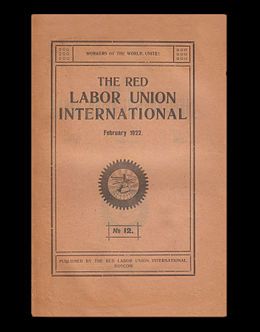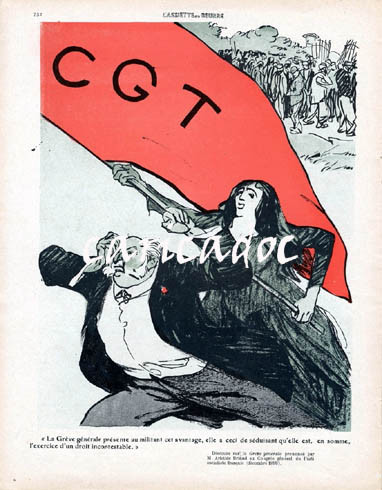During the 1917 Russian Revolution, anarchists were at the forefront of the anti-bureaucratic factory committee movement. While Boris Yelensky and his anarchist comrades were busy organizing factory committees in the Kuban region in southern Russia, anarchists took a leading role in the factory committee movements in other parts of Russia, Petrograd in particular. The anarchists initiated the factory committee movement before the 1917 October Revolution, seeing the factory committees as forming a more solid basis for genuine workers’ control, given the control of the Russian trade union movement by the political parties. Gregory Maksimov was one of the leading anarchist proponents of the factory committees, organizing the first conference of Petrograd Factory Committees in June 1917. As the name implies, the factory committees were based in the workplace, and organized on a directly democratic basis. In contrast, the Soviets, along with most trade unions, were dominated by political parties that in practice favoured a representative system of government. After the October Revolution, the Soviets became increasingly under the control of the Bolsheviks, causing Maksimov and other anarchists to seek to expand the factory committee movement as one that would achieve genuine workers’ control. By December 1917, Maksimov was already warning the Russian people that the Soviets were becoming organs of state power. In his article, “The Soviets of Workers’, Soldiers’ and Peasants’ Deputies,” reprinted in Volume One of Anarchism: A Documentary History of Libertarian Ideas, Maksimov called for a “Third Revolution” that, following the February and October Revolutions, would, through the factory committee movement, bring about genuine workers’ control, or worker self-management. The excerpts below are taken from Maksimov’s later pamphlet, Syndicalists in the Russian Revolution.
“Centralism via Federalism”
The influence of Anarcho-Syndicalism showed itself creditably in the struggle for supremacy waged by the Factory Committees against the trade unions. The Factory Committees were almost completely swayed by a unique sort of Anarcho-Syndicalism; this is attested by all the conferences of the Petrograd Factory Committees, and by the All-Russian conferences of these committees. Moreover, the Bolsheviks in their drive towards seizure of power and dictatorship, were forced to cast away (for the time being only, as subsequent events proved), their orthodox Marxism and to accept Anarchist slogans and methods.
Alas, this was but a tactical move on their part, not a genuine change of program. The slogans formulated by the Bolsheviks (Communists) voiced, in a precise and intelligible manner, the demands of the masses in revolt, coinciding with the slogans of the Anarchists: “Down with the war,” “Immediate peace without annexations or indemnities, over the heads of the governments and capitalists,” “Abolition of the army,” “Arming of the workers,” “Immediate seizure of land by the peasants,” “Seizure of factories by the workers,” “A Federation of Soviets,” etc. Wouldn’t the realization of these great slogans lead to the full triumph of Anarchist ideology, to the sweeping away of the basis and foundations of Marxism? Wasn’t it natural for the Anarchists to be taken in by these slogans, considering that they lacked a strong organization to carry them out independently? Consequently, they continued taking part in the joint struggle.
But reality soon proved that all the lapses by the Bolsheviks from the revolutionary position were no casual things, but moves in a rigorously thought-out tactical plan, directed against the vital interests and demands of the masses – a plan designed to carry out in life the dead dogmas of a disintegrated Marxism. The true face of the Bolsheviks was revealed by the Commissar of National Affairs~Stalin (Dzhugashvili), who in one of his articles (April 1918) wrote that their aim is, “To arrive at centralism via federalism.” Persistently, cautiously, the revolution was being forced into Marxist channels in accordance with a preconceived plan. Such a channel is for every popular creed a Procrustean bed.
Thus, during the period of the Bourgeois and Bourgeois Socialist Government, the Anarchists worked (not organizationally of course) hand-in-hand with the Bolsheviks. How were the Anarchists situated during that period? The listing of the cities where Anarchist publications came out shows that freedom of the press was of the most extensive kind. Not a single newspaper was closed, not a single leaflet, pamphlet or book confiscated, not a single rally or mass meeting forbidden. Despite the seizure of rich private houses, like the Durnovo Villa and other mansions in Petrograd; despite the seizure of printing shops, including the printing shop of Russkaya Volia, published by the Tsar’s minister Protopopov; despite open incitement to insubordination and appeals for soldiers to leave the fronts; despite all that, only a few cases where Anarchists were manhandled might be construed as connivance by authorities, or premeditated acts. True, the government, at that period, was not averse to dealing severely with both Anarchists and Bolsheviks. Kerensky threatened many times to “burn them out with red-hot irons”. But the government was powerless, because the revolution was in full swing.
After October
How did the position of the Anarchists change with the triumph of the October revolution, in the preparation and making of which they had taken such a prominent part? It has to be pointed out that during the Kerensky period the Anarchists had grown considerably and that towards the October days their movement had already assumed considerable proportions. This growth became even more accelerated after the October revolution, when the Anarchists took an active part in the direct struggle against both the counter-revolution and the German-Austrian troops. Not only did the voice of the Anarchists command attention, but the masses actually followed the appeals and directives of the Anarchists, having come to see in them the concrete formulation of their age-long aspirations. That is why they backed demands of an Anarcho-Syndicalist character, carrying them out in the teeth of hamstringing efforts, rather feeble at that time, by the Bolsheviks.
Under the influence of Anarcho-Syndicalist propaganda, there began in Petrograd a spontaneous process of socialization of housing by the house committees. This extended to entire streets, bringing into existence street committees and block committees, when entire blocks were drawn in. It spread to other cities. In Kronstadt it started even earlier than Petrograd and reached even greater intensity. If in Petrograd and other cities, dwellings were socialized only on the triumph of the October revolution, in Kronstadt similar steps were taken earlier, under the influence of Yartchuk, who was enjoying great popularity in that town, and in face of the active resistance of the Bolsheviks. Measures of this kind were carried out in an organized way by the revolutionary workers and sailors throughout the town. The Bolshevik fraction left a session of the Kronstadt Soviet in protest against the socialization of dwellings.
Workers’ Control
In the field of revolutionary struggle towards immediate abolition of the institution of private property in the means of production, the influence of the Anarchists was even more pronounced. The idea of “workers’ control”, carried out through the Factory Committees, an idea advocated by the Anarcho-Syndicalists from the very outset of the revolution, took root among the city workers, gaining such a strong hold on them as to force its acceptance, in a distorted form, of course, by the Socialist parties. The Social Democrats and the right Social-Revolutionists twisted this idea of workers’ control into that of State control over industry, with the participation of workers, leaving enterprises in the hands of the capitalists.
As for the Bolsheviks, they were quite vague about the meaning of the term “workers’ control”, leaving it undefined, and making it a handy tool of demagogic propaganda. This is confirmed by [the Bolshevik writer] A. Lozovsky (S. A. Dridzo), who writes the following in his pamphlet Workers’ Control (Petersburg: Socialist Publishing House, 1918):
“Workers’ control was the fighting slogan of the Bolsheviks before the October days . . . but despite the fact that workers’ control figured in all resolutions, and was displayed on all banners, it had an aura of mystery about it. The party Press wrote very little about this slogan, still less did it try to implement it in a concrete way. When the October revolution broke out and it became necessary to say clearly and precisely what this workers’ control was, it developed that, even among the partisans of this slogan, there existed great differences of opinion on that score” (p. 19).
The Bolsheviks refused to accept the Anarcho-Syndicalist construction of the idea of workers’ control: namely, taking control of production, its socialization and instituting workers’ control over socialized production through the Factory Committees. This idea won out, workers having begun expropriating enterprises while the Bourgeois-Socialist government was still in power. The Factory Committees and various control committees were already taking over the managing functions at that time. On the eve of the October revolution this movement assumed a truly mass character.
Factory Committees
The Factory Committees and their Central Bureau became the foundation of the new revolutionary movement, which set itself the task of making the factories into Producer and Consumer Communes. The Factory Committees were to become the nuclei of the new social order gradually emerging from the inchoate elemental life of the revolution. Anarchistic in their essence, the Factory Committees made many enemies. The attitude of all political parties was restrained hostility, their efforts centering on reducing the Factory Committees to a subordinate position within the trade unions.
The Communists [Bolsheviks] from the outset showed their suspicion of this type of organization. It was only after they had become convinced that the trade unions were too strongly dominated by the Social-Democrats to lend themselves as instruments of Communist policy that, following the Anarcho-Syndicalists, they began to centre their attention on the Factory Committees, aiming to place them under their control and, through those committees, ultimately to gain control of the trade unions. Despite this attitude, the Bolsheviks were forced by the course of events to assume a position toward the Factory Committees which differed little from that of the Anarcho-Syndicalists. Only gradually did they assume this position. At first they combatted it.
“The Anarcho-Syndicalists entrenched themselves behind the Factory Committees. They created a veritable theory around it, saying in effect that the trade unions have died, that the future belongs to the Factory Committees, who will deliver the knock-out blow to capitalism, that the Factory Committees are the highest form of labour movement, etc. In a word, they developed in regard to the Factory Committees the same theory which the French Anarcho-Syndicalists developed in regard to the trade unions. Under these conditions the divorce between the two organizations (trade unions and Factory Committees) represents the greatest danger for the labour movement of Russia.”
“This danger is the greater, that even among active people of the Factory Committees who are not Anarcho-Syndicalists, we also see this tendency to oppose the trade unions to the Factory Committees and even to replace industrial unions and their local branches with respective organizations of the Factory Committee type” – Lozovsky, Workers’ Control (p. 37).
Seizure of enterprises
Characteristically, only the Anarcho-Syndicalist press correctly evaluated the role and significance of the Factory Committees. The first article in the revolutionary press on this problem, by the author of these lines, appeared in the first issue of Golos Truda. (Incidentally, the article did not express the opinion of Golos Truda as a whole on this problem.) At one of the conferences of the Factory Committees held in Petrograd, during August, 1917, the article was hotly contested by the Bolsheviks, notably Lozovsky and others. But this idea, sound in itself and answering the mood and needs of the workers, became dominant even in the Bolshevik Party. Even Lenin declared in his speech at the All-Russian Trade Union Convention (held in the spring of 1918) that “the factory is a self-governing commune of producers and consumers.”
The results of this Anarcho-Syndicalist propaganda soon bore fruit. There followed a wave of seizures of enterprises and the organization of Workers’ Management. These began when the provisional government was still in power and, it stands to reason, the Anarchists played the foremost role in them. The most talked-of event of the kind at that period was the expropriation under the direct influence of the Anarchist Zhuk, of the Shlisselburg gunpowder mills and agricultural estates, both of which were then organized on Anarchist principles. Such events recurred ever more frequently, and on the eve of the October revolution they came to be regarded as a matter of course. Soon after the triumph of the October revolution, the Central Bureau of the Factory Committees worked out extensive instructions for the control of production. These instructions proved to be a brilliant literary document, showing the triumph of the Anarcho-Syndicalist idea. The significance of this incident is the greater considering that the Bolsheviks were then predominant in the Factory Committees.
How greatly the workers were influenced by the idea of Factory Committees being the executive bodies of the Factory-Communes – the cellular bodies joining into a federative organization, which unites all workers and creates the necessary industrial administrative system – is shown by the uneasiness the Bolsheviks revealed after the October revolution.
“In place of a ‘Republic of Soviets’, we are led to a republic of producers’ co-operatives (artels), into which the capitalist factories would be metamorphosed by this process. Instead of a rapid regulation of the social production and consumption – instead of measures which, objected to as they may be on various grounds, do represent a genuine step toward a socialist organization of society – instead of that we are witnessing something which partakes somewhat of the Anarchist visionary dreams about autonomous industrial communes” – I. Stepanov, From Workers’ Control Towards Workers’ Administration in the Industries and Agriculture (Moscow: 1918, p. 11).
The predominance of the Bolsheviks makes even more remarkable the successes achieved by our comrades, especially that of W. Shatov, in their work carried on within the Factory Committees. (Shatov led the attack on the Winter Palace, Petrograd, in October 1917. He left the Anarcho-Syndicalist movement and became in fact a Bolshevik from the very moment when the capital was moved to Moscow early in 1918. He was arrested and probably shot without trial during the purges in the late 1930s.) Even though dominated by the Bolsheviks, the Factory Committees of that period were carrying out the Anarchist idea. The latter, of course, suffered in clarity and purity when carried out by the Bolsheviks within the Factory Committees; had the Anarchists been in the majority they would have tried to eliminate completely from the work of the committees the element of centralization and State principles.
Gregory Maksimov












































